Nursing Education: Evaluating Simulation Technology at Missouri Uni
VerifiedAdded on 2023/06/10
|7
|1620
|386
Essay
AI Summary
This essay evaluates the impact of simulation technology on nursing education at the University of Missouri. It analyzes the positive and negative influences of simulation technology on nursing education and patient care. The essay recommends that the University of Missouri install special technology to track the effect of simulation technology. It discusses the University's mission, vision, and values in relation to simulation technology and its impact on day-to-day nursing operations, including the use of scaffolding approaches and virtual environments. The essay also addresses the impact on patient care, emphasizing the importance of tracking patient outcomes and nurse experiences. It also suggests preparing for technology failures by using mannequin simulators. Furthermore, it suggests incorporating the change in technology using Kurt Lewin’s change management model. Finally, it concludes that simulation technology is effective in improving nursing education and patient care, provided that proper change management principles are followed.
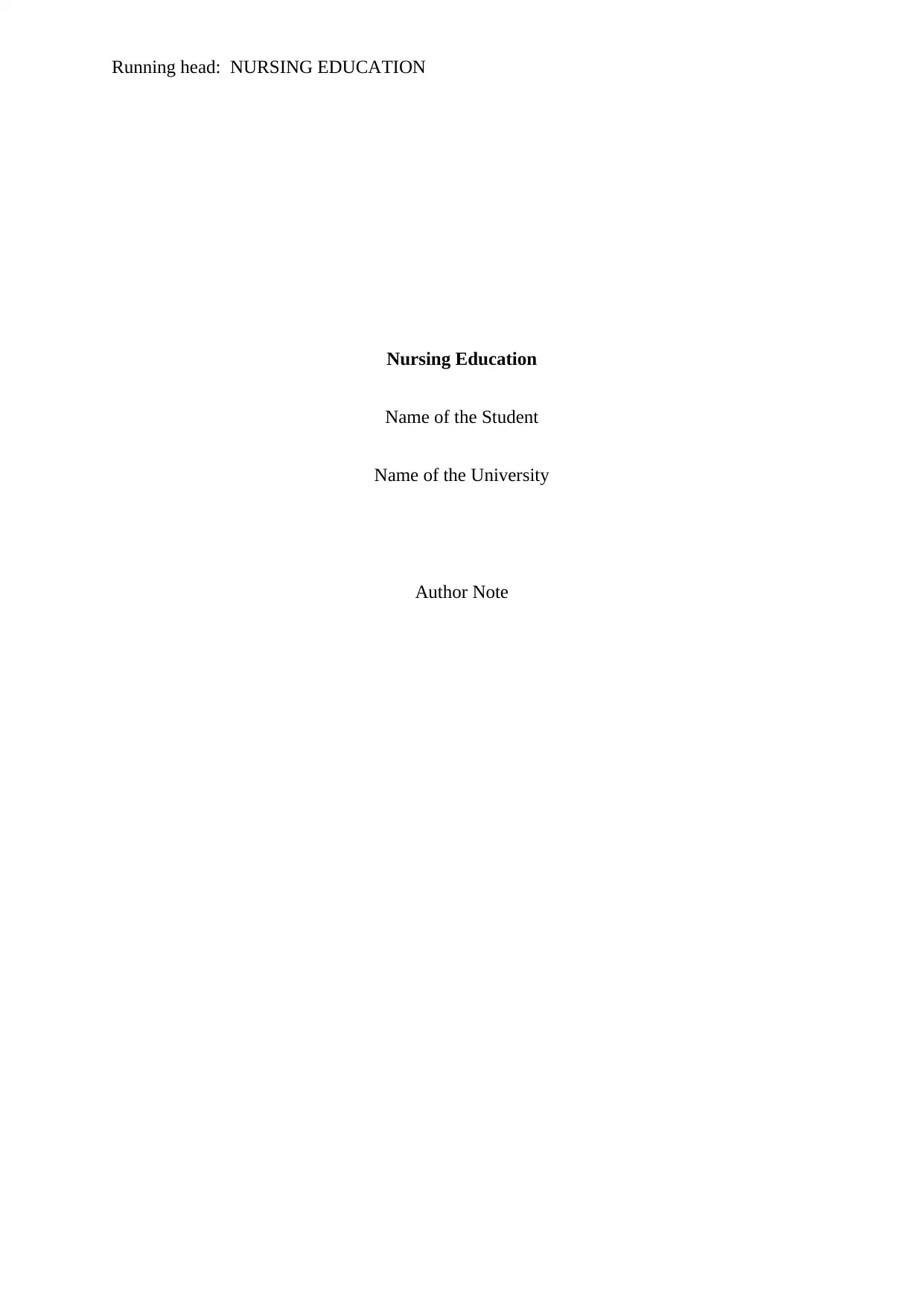
Running head: NURSING EDUCATION
Nursing Education
Name of the Student
Name of the University
Author Note
Nursing Education
Name of the Student
Name of the University
Author Note
Paraphrase This Document
Need a fresh take? Get an instant paraphrase of this document with our AI Paraphraser
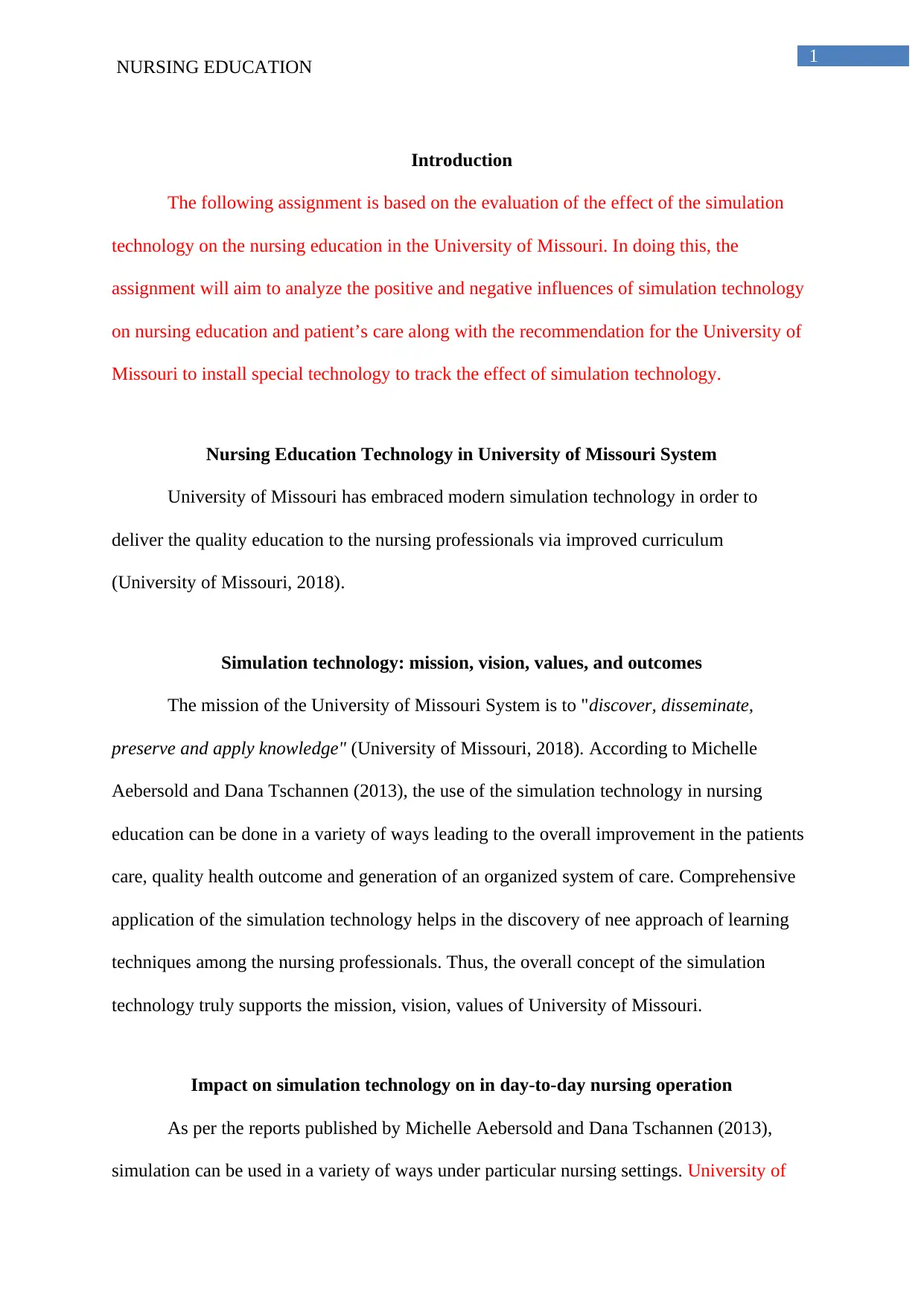
1
NURSING EDUCATION
Introduction
The following assignment is based on the evaluation of the effect of the simulation
technology on the nursing education in the University of Missouri. In doing this, the
assignment will aim to analyze the positive and negative influences of simulation technology
on nursing education and patient’s care along with the recommendation for the University of
Missouri to install special technology to track the effect of simulation technology.
Nursing Education Technology in University of Missouri System
University of Missouri has embraced modern simulation technology in order to
deliver the quality education to the nursing professionals via improved curriculum
(University of Missouri, 2018).
Simulation technology: mission, vision, values, and outcomes
The mission of the University of Missouri System is to "discover, disseminate,
preserve and apply knowledge" (University of Missouri, 2018). According to Michelle
Aebersold and Dana Tschannen (2013), the use of the simulation technology in nursing
education can be done in a variety of ways leading to the overall improvement in the patients
care, quality health outcome and generation of an organized system of care. Comprehensive
application of the simulation technology helps in the discovery of nee approach of learning
techniques among the nursing professionals. Thus, the overall concept of the simulation
technology truly supports the mission, vision, values of University of Missouri.
Impact on simulation technology on in day-to-day nursing operation
As per the reports published by Michelle Aebersold and Dana Tschannen (2013),
simulation can be used in a variety of ways under particular nursing settings. University of
NURSING EDUCATION
Introduction
The following assignment is based on the evaluation of the effect of the simulation
technology on the nursing education in the University of Missouri. In doing this, the
assignment will aim to analyze the positive and negative influences of simulation technology
on nursing education and patient’s care along with the recommendation for the University of
Missouri to install special technology to track the effect of simulation technology.
Nursing Education Technology in University of Missouri System
University of Missouri has embraced modern simulation technology in order to
deliver the quality education to the nursing professionals via improved curriculum
(University of Missouri, 2018).
Simulation technology: mission, vision, values, and outcomes
The mission of the University of Missouri System is to "discover, disseminate,
preserve and apply knowledge" (University of Missouri, 2018). According to Michelle
Aebersold and Dana Tschannen (2013), the use of the simulation technology in nursing
education can be done in a variety of ways leading to the overall improvement in the patients
care, quality health outcome and generation of an organized system of care. Comprehensive
application of the simulation technology helps in the discovery of nee approach of learning
techniques among the nursing professionals. Thus, the overall concept of the simulation
technology truly supports the mission, vision, values of University of Missouri.
Impact on simulation technology on in day-to-day nursing operation
As per the reports published by Michelle Aebersold and Dana Tschannen (2013),
simulation can be used in a variety of ways under particular nursing settings. University of
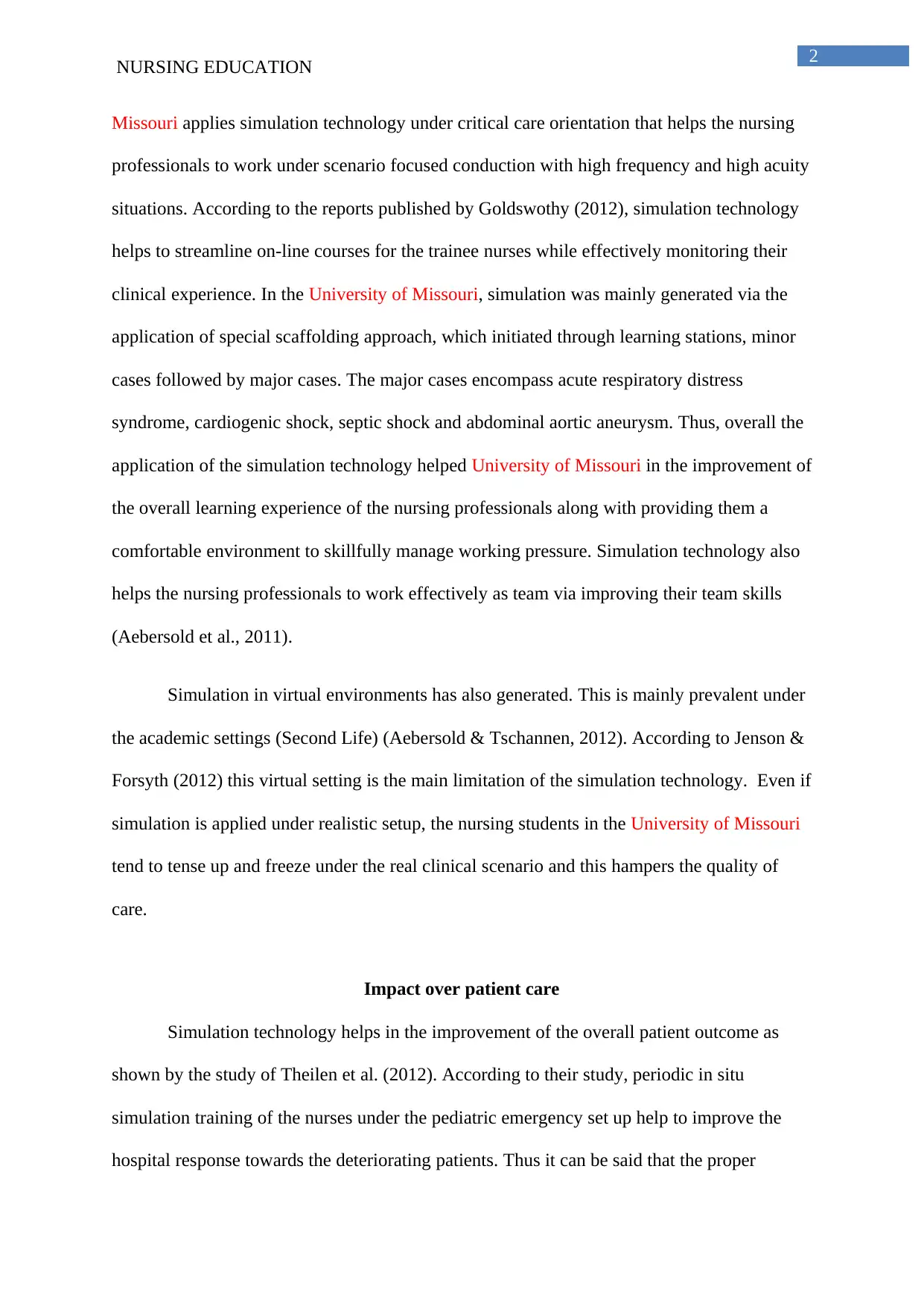
2
NURSING EDUCATION
Missouri applies simulation technology under critical care orientation that helps the nursing
professionals to work under scenario focused conduction with high frequency and high acuity
situations. According to the reports published by Goldswothy (2012), simulation technology
helps to streamline on-line courses for the trainee nurses while effectively monitoring their
clinical experience. In the University of Missouri, simulation was mainly generated via the
application of special scaffolding approach, which initiated through learning stations, minor
cases followed by major cases. The major cases encompass acute respiratory distress
syndrome, cardiogenic shock, septic shock and abdominal aortic aneurysm. Thus, overall the
application of the simulation technology helped University of Missouri in the improvement of
the overall learning experience of the nursing professionals along with providing them a
comfortable environment to skillfully manage working pressure. Simulation technology also
helps the nursing professionals to work effectively as team via improving their team skills
(Aebersold et al., 2011).
Simulation in virtual environments has also generated. This is mainly prevalent under
the academic settings (Second Life) (Aebersold & Tschannen, 2012). According to Jenson &
Forsyth (2012) this virtual setting is the main limitation of the simulation technology. Even if
simulation is applied under realistic setup, the nursing students in the University of Missouri
tend to tense up and freeze under the real clinical scenario and this hampers the quality of
care.
Impact over patient care
Simulation technology helps in the improvement of the overall patient outcome as
shown by the study of Theilen et al. (2012). According to their study, periodic in situ
simulation training of the nurses under the pediatric emergency set up help to improve the
hospital response towards the deteriorating patients. Thus it can be said that the proper
NURSING EDUCATION
Missouri applies simulation technology under critical care orientation that helps the nursing
professionals to work under scenario focused conduction with high frequency and high acuity
situations. According to the reports published by Goldswothy (2012), simulation technology
helps to streamline on-line courses for the trainee nurses while effectively monitoring their
clinical experience. In the University of Missouri, simulation was mainly generated via the
application of special scaffolding approach, which initiated through learning stations, minor
cases followed by major cases. The major cases encompass acute respiratory distress
syndrome, cardiogenic shock, septic shock and abdominal aortic aneurysm. Thus, overall the
application of the simulation technology helped University of Missouri in the improvement of
the overall learning experience of the nursing professionals along with providing them a
comfortable environment to skillfully manage working pressure. Simulation technology also
helps the nursing professionals to work effectively as team via improving their team skills
(Aebersold et al., 2011).
Simulation in virtual environments has also generated. This is mainly prevalent under
the academic settings (Second Life) (Aebersold & Tschannen, 2012). According to Jenson &
Forsyth (2012) this virtual setting is the main limitation of the simulation technology. Even if
simulation is applied under realistic setup, the nursing students in the University of Missouri
tend to tense up and freeze under the real clinical scenario and this hampers the quality of
care.
Impact over patient care
Simulation technology helps in the improvement of the overall patient outcome as
shown by the study of Theilen et al. (2012). According to their study, periodic in situ
simulation training of the nurses under the pediatric emergency set up help to improve the
hospital response towards the deteriorating patients. Thus it can be said that the proper
⊘ This is a preview!⊘
Do you want full access?
Subscribe today to unlock all pages.

Trusted by 1+ million students worldwide
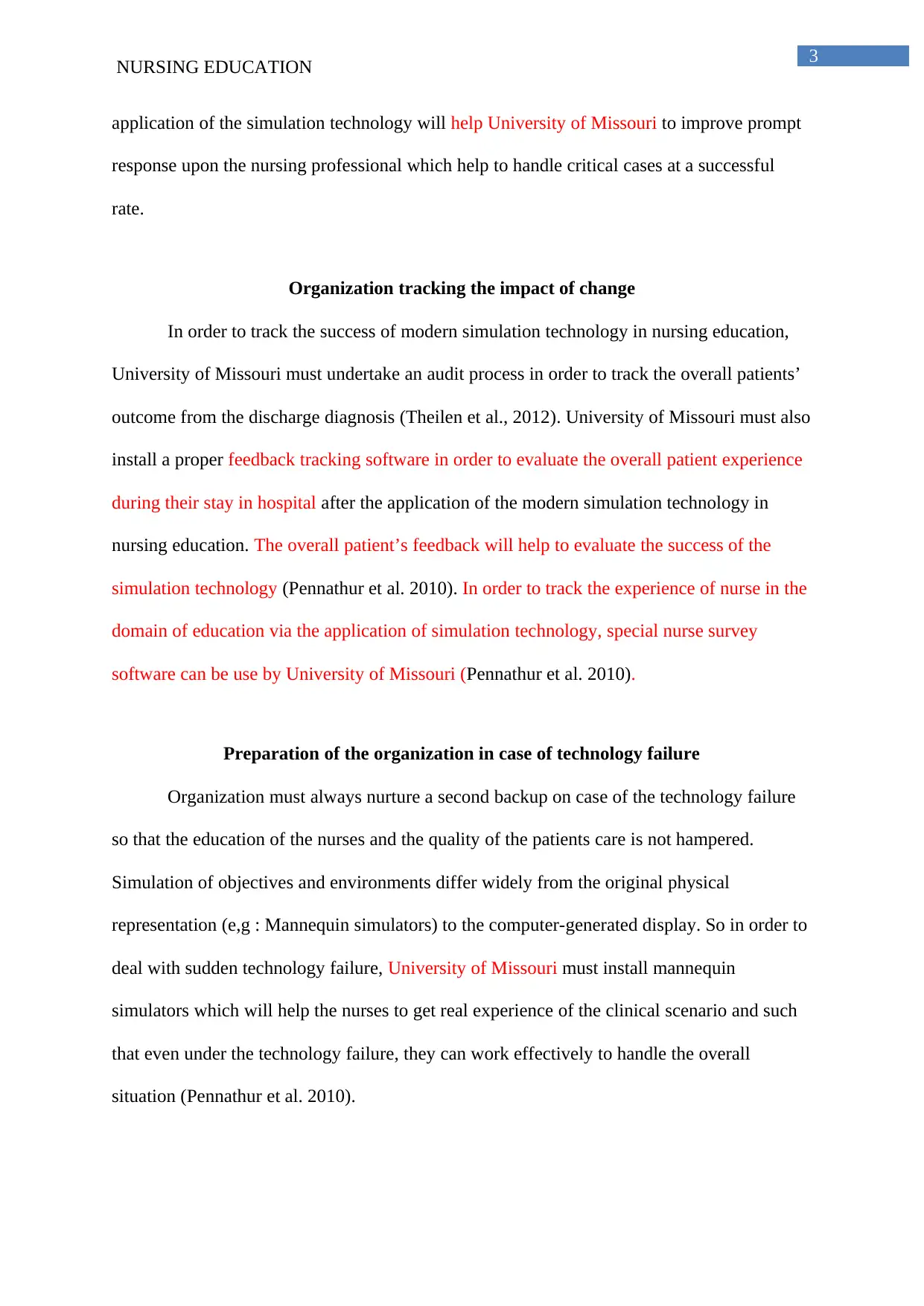
3
NURSING EDUCATION
application of the simulation technology will help University of Missouri to improve prompt
response upon the nursing professional which help to handle critical cases at a successful
rate.
Organization tracking the impact of change
In order to track the success of modern simulation technology in nursing education,
University of Missouri must undertake an audit process in order to track the overall patients’
outcome from the discharge diagnosis (Theilen et al., 2012). University of Missouri must also
install a proper feedback tracking software in order to evaluate the overall patient experience
during their stay in hospital after the application of the modern simulation technology in
nursing education. The overall patient’s feedback will help to evaluate the success of the
simulation technology (Pennathur et al. 2010). In order to track the experience of nurse in the
domain of education via the application of simulation technology, special nurse survey
software can be use by University of Missouri (Pennathur et al. 2010).
Preparation of the organization in case of technology failure
Organization must always nurture a second backup on case of the technology failure
so that the education of the nurses and the quality of the patients care is not hampered.
Simulation of objectives and environments differ widely from the original physical
representation (e,g : Mannequin simulators) to the computer-generated display. So in order to
deal with sudden technology failure, University of Missouri must install mannequin
simulators which will help the nurses to get real experience of the clinical scenario and such
that even under the technology failure, they can work effectively to handle the overall
situation (Pennathur et al. 2010).
NURSING EDUCATION
application of the simulation technology will help University of Missouri to improve prompt
response upon the nursing professional which help to handle critical cases at a successful
rate.
Organization tracking the impact of change
In order to track the success of modern simulation technology in nursing education,
University of Missouri must undertake an audit process in order to track the overall patients’
outcome from the discharge diagnosis (Theilen et al., 2012). University of Missouri must also
install a proper feedback tracking software in order to evaluate the overall patient experience
during their stay in hospital after the application of the modern simulation technology in
nursing education. The overall patient’s feedback will help to evaluate the success of the
simulation technology (Pennathur et al. 2010). In order to track the experience of nurse in the
domain of education via the application of simulation technology, special nurse survey
software can be use by University of Missouri (Pennathur et al. 2010).
Preparation of the organization in case of technology failure
Organization must always nurture a second backup on case of the technology failure
so that the education of the nurses and the quality of the patients care is not hampered.
Simulation of objectives and environments differ widely from the original physical
representation (e,g : Mannequin simulators) to the computer-generated display. So in order to
deal with sudden technology failure, University of Missouri must install mannequin
simulators which will help the nurses to get real experience of the clinical scenario and such
that even under the technology failure, they can work effectively to handle the overall
situation (Pennathur et al. 2010).
Paraphrase This Document
Need a fresh take? Get an instant paraphrase of this document with our AI Paraphraser

4
NURSING EDUCATION
Incorporation of the change in technology
In order to incorporate change in technology in the design of the nursing education,
the University of Missouri must apply proper change management model like the Kurt Lewin
Change Management model. The subsequent three steps of the Kurt Lewin’s change
management model unfreezing, changing and refreezing) will help in the generation of the
awareness for change, implementation of the change and successfully getting accustomed
under the changed environment (Shirey, 2013).
Benefits of technology in nursing education
Application of technology in the learning and professional practice of the nurses helps
to improve the overall health outcomes of the patients along with generation of an organized
healthcare system. Interaction tools and adaptive learning help to create better outcomes.
Application of the simulation technology in the nursing education will help the nurse
educators and their students in University of Missouri to achieve better outcomes on their
high-stake tests. It also help in the generation of personalized learning experience via
detecting the domains of weakness and providing relevant content and remediation tools
(Mastrian et al., 2011).
Conclusion
Thus from the discussion it can be concluded that simulation technology is effective
in improving the overall process of nursing education and the quality of patient care.
However, proper change management principal needs to be undertaken in order to implement
this new technological change in the University Missouri.
NURSING EDUCATION
Incorporation of the change in technology
In order to incorporate change in technology in the design of the nursing education,
the University of Missouri must apply proper change management model like the Kurt Lewin
Change Management model. The subsequent three steps of the Kurt Lewin’s change
management model unfreezing, changing and refreezing) will help in the generation of the
awareness for change, implementation of the change and successfully getting accustomed
under the changed environment (Shirey, 2013).
Benefits of technology in nursing education
Application of technology in the learning and professional practice of the nurses helps
to improve the overall health outcomes of the patients along with generation of an organized
healthcare system. Interaction tools and adaptive learning help to create better outcomes.
Application of the simulation technology in the nursing education will help the nurse
educators and their students in University of Missouri to achieve better outcomes on their
high-stake tests. It also help in the generation of personalized learning experience via
detecting the domains of weakness and providing relevant content and remediation tools
(Mastrian et al., 2011).
Conclusion
Thus from the discussion it can be concluded that simulation technology is effective
in improving the overall process of nursing education and the quality of patient care.
However, proper change management principal needs to be undertaken in order to implement
this new technological change in the University Missouri.
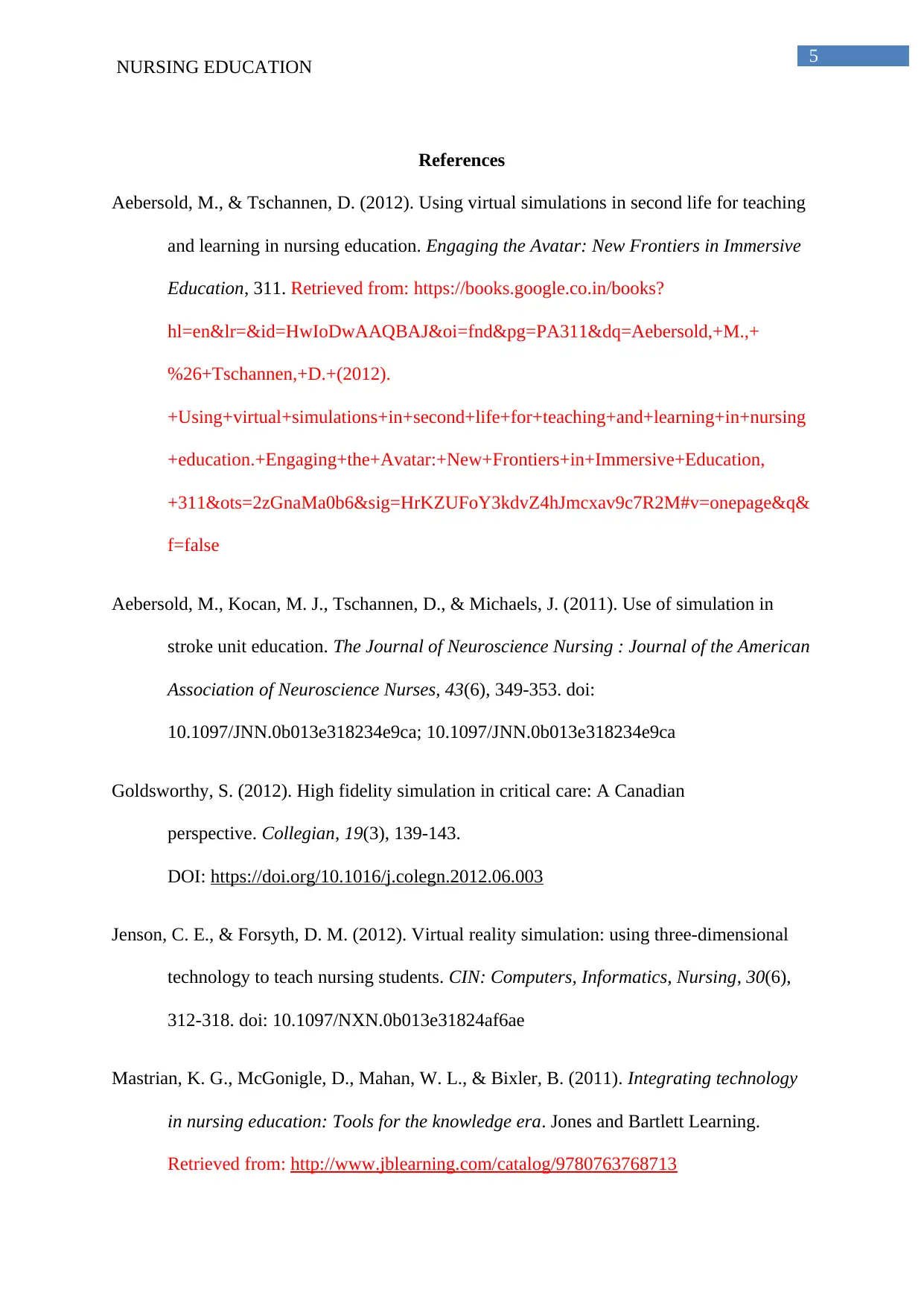
5
NURSING EDUCATION
References
Aebersold, M., & Tschannen, D. (2012). Using virtual simulations in second life for teaching
and learning in nursing education. Engaging the Avatar: New Frontiers in Immersive
Education, 311. Retrieved from: https://books.google.co.in/books?
hl=en&lr=&id=HwIoDwAAQBAJ&oi=fnd&pg=PA311&dq=Aebersold,+M.,+
%26+Tschannen,+D.+(2012).
+Using+virtual+simulations+in+second+life+for+teaching+and+learning+in+nursing
+education.+Engaging+the+Avatar:+New+Frontiers+in+Immersive+Education,
+311&ots=2zGnaMa0b6&sig=HrKZUFoY3kdvZ4hJmcxav9c7R2M#v=onepage&q&
f=false
Aebersold, M., Kocan, M. J., Tschannen, D., & Michaels, J. (2011). Use of simulation in
stroke unit education. The Journal of Neuroscience Nursing : Journal of the American
Association of Neuroscience Nurses, 43(6), 349-353. doi:
10.1097/JNN.0b013e318234e9ca; 10.1097/JNN.0b013e318234e9ca
Goldsworthy, S. (2012). High fidelity simulation in critical care: A Canadian
perspective. Collegian, 19(3), 139-143.
DOI: https://doi.org/10.1016/j.colegn.2012.06.003
Jenson, C. E., & Forsyth, D. M. (2012). Virtual reality simulation: using three-dimensional
technology to teach nursing students. CIN: Computers, Informatics, Nursing, 30(6),
312-318. doi: 10.1097/NXN.0b013e31824af6ae
Mastrian, K. G., McGonigle, D., Mahan, W. L., & Bixler, B. (2011). Integrating technology
in nursing education: Tools for the knowledge era. Jones and Bartlett Learning.
Retrieved from: http://www.jblearning.com/catalog/9780763768713
NURSING EDUCATION
References
Aebersold, M., & Tschannen, D. (2012). Using virtual simulations in second life for teaching
and learning in nursing education. Engaging the Avatar: New Frontiers in Immersive
Education, 311. Retrieved from: https://books.google.co.in/books?
hl=en&lr=&id=HwIoDwAAQBAJ&oi=fnd&pg=PA311&dq=Aebersold,+M.,+
%26+Tschannen,+D.+(2012).
+Using+virtual+simulations+in+second+life+for+teaching+and+learning+in+nursing
+education.+Engaging+the+Avatar:+New+Frontiers+in+Immersive+Education,
+311&ots=2zGnaMa0b6&sig=HrKZUFoY3kdvZ4hJmcxav9c7R2M#v=onepage&q&
f=false
Aebersold, M., Kocan, M. J., Tschannen, D., & Michaels, J. (2011). Use of simulation in
stroke unit education. The Journal of Neuroscience Nursing : Journal of the American
Association of Neuroscience Nurses, 43(6), 349-353. doi:
10.1097/JNN.0b013e318234e9ca; 10.1097/JNN.0b013e318234e9ca
Goldsworthy, S. (2012). High fidelity simulation in critical care: A Canadian
perspective. Collegian, 19(3), 139-143.
DOI: https://doi.org/10.1016/j.colegn.2012.06.003
Jenson, C. E., & Forsyth, D. M. (2012). Virtual reality simulation: using three-dimensional
technology to teach nursing students. CIN: Computers, Informatics, Nursing, 30(6),
312-318. doi: 10.1097/NXN.0b013e31824af6ae
Mastrian, K. G., McGonigle, D., Mahan, W. L., & Bixler, B. (2011). Integrating technology
in nursing education: Tools for the knowledge era. Jones and Bartlett Learning.
Retrieved from: http://www.jblearning.com/catalog/9780763768713
⊘ This is a preview!⊘
Do you want full access?
Subscribe today to unlock all pages.

Trusted by 1+ million students worldwide
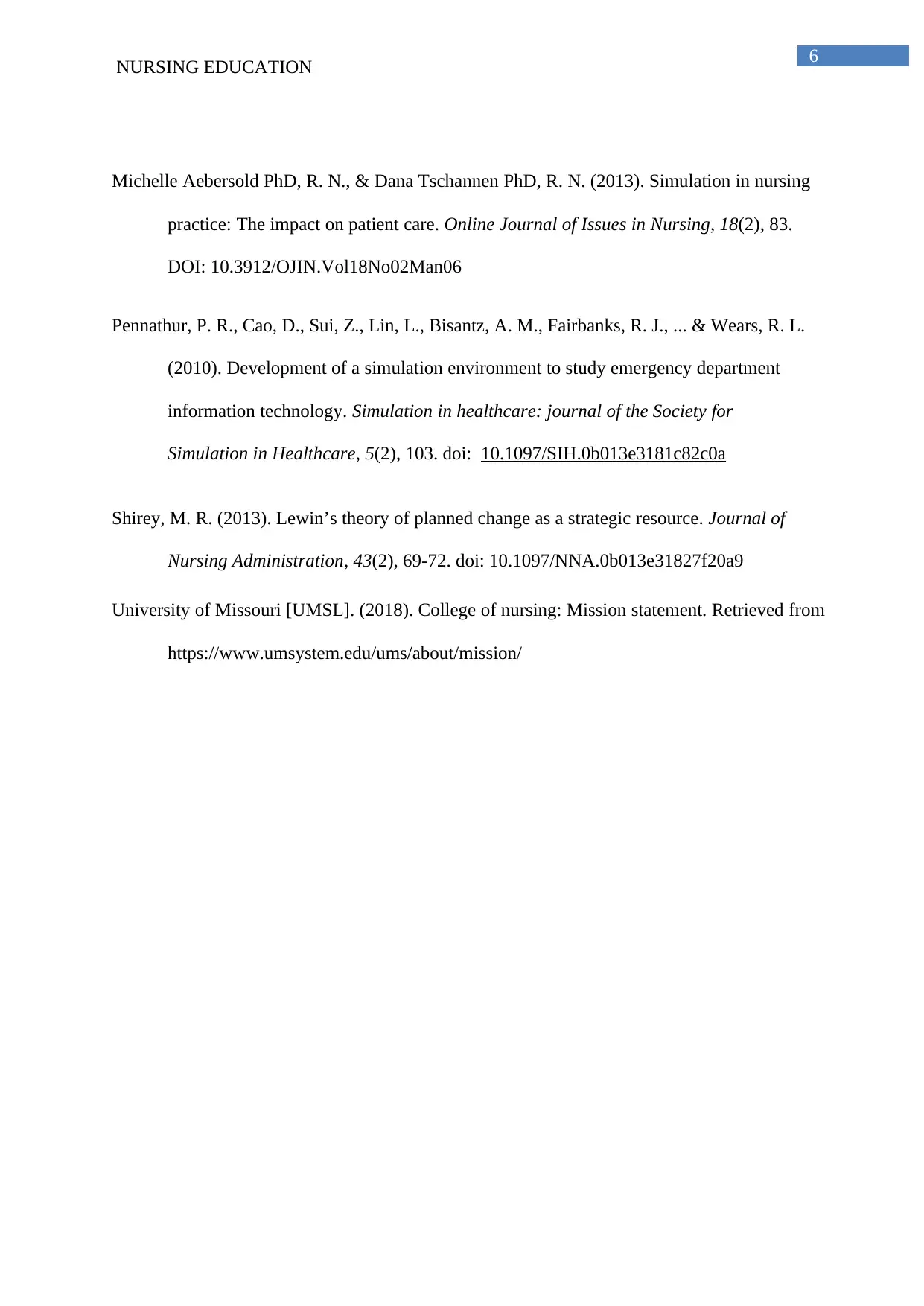
6
NURSING EDUCATION
Michelle Aebersold PhD, R. N., & Dana Tschannen PhD, R. N. (2013). Simulation in nursing
practice: The impact on patient care. Online Journal of Issues in Nursing, 18(2), 83.
DOI: 10.3912/OJIN.Vol18No02Man06
Pennathur, P. R., Cao, D., Sui, Z., Lin, L., Bisantz, A. M., Fairbanks, R. J., ... & Wears, R. L.
(2010). Development of a simulation environment to study emergency department
information technology. Simulation in healthcare: journal of the Society for
Simulation in Healthcare, 5(2), 103. doi: 10.1097/SIH.0b013e3181c82c0a
Shirey, M. R. (2013). Lewin’s theory of planned change as a strategic resource. Journal of
Nursing Administration, 43(2), 69-72. doi: 10.1097/NNA.0b013e31827f20a9
University of Missouri [UMSL]. (2018). College of nursing: Mission statement. Retrieved from
https://www.umsystem.edu/ums/about/mission/
NURSING EDUCATION
Michelle Aebersold PhD, R. N., & Dana Tschannen PhD, R. N. (2013). Simulation in nursing
practice: The impact on patient care. Online Journal of Issues in Nursing, 18(2), 83.
DOI: 10.3912/OJIN.Vol18No02Man06
Pennathur, P. R., Cao, D., Sui, Z., Lin, L., Bisantz, A. M., Fairbanks, R. J., ... & Wears, R. L.
(2010). Development of a simulation environment to study emergency department
information technology. Simulation in healthcare: journal of the Society for
Simulation in Healthcare, 5(2), 103. doi: 10.1097/SIH.0b013e3181c82c0a
Shirey, M. R. (2013). Lewin’s theory of planned change as a strategic resource. Journal of
Nursing Administration, 43(2), 69-72. doi: 10.1097/NNA.0b013e31827f20a9
University of Missouri [UMSL]. (2018). College of nursing: Mission statement. Retrieved from
https://www.umsystem.edu/ums/about/mission/
1 out of 7
Related Documents
Your All-in-One AI-Powered Toolkit for Academic Success.
+13062052269
info@desklib.com
Available 24*7 on WhatsApp / Email
![[object Object]](/_next/static/media/star-bottom.7253800d.svg)
Unlock your academic potential
Copyright © 2020–2025 A2Z Services. All Rights Reserved. Developed and managed by ZUCOL.





